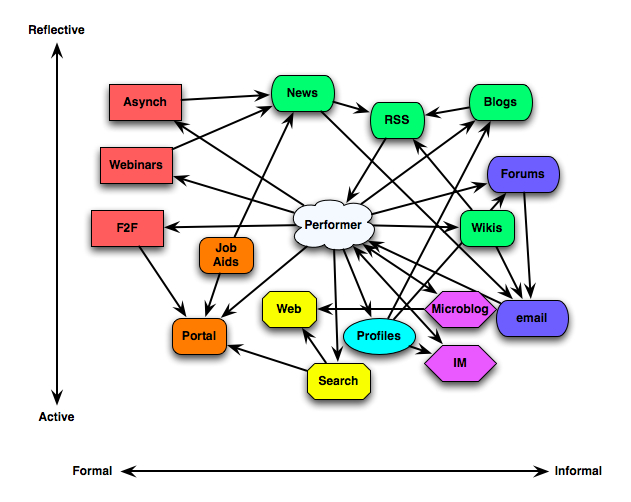I like going to conferences: exchanging ideas, meeting new people, and just variety. However, I haven’t been on the road since early June for any conferences, after running a workshop at ASTD’s international conference and then presenting at DAU/GMU’s Innovations in eLearning Conference. But it’s that time again.
First, Jay Cross and I will be presenting on the Chief Meta-Learning Officer article we wrote at the Fall CLO Symposium Sept 28-30. We’ll be riffing on the results of the survey we made available as part of the article, looking at what folks are saying about how their organization is learning. There are big opportunities for organizations to improve how the facilitate and leverage their employee ideas, and we’re hoping to help that vision come forth.
![]() At DevLearn (Nov 10-13), Jay and I will be running a 1 day workshop on how to be a Chief Meta-Learning Officer, and I expect we’ll capture some of the process and outcomes that led my attendees at the elearning strategy workshop to say things like “powerful and overwhelming – in a good way!”, “Very current for today‘s priorities”, “extremely useful … I learned so much”, and “Really makes the shift from just
At DevLearn (Nov 10-13), Jay and I will be running a 1 day workshop on how to be a Chief Meta-Learning Officer, and I expect we’ll capture some of the process and outcomes that led my attendees at the elearning strategy workshop to say things like “powerful and overwhelming – in a good way!”, “Very current for today‘s priorities”, “extremely useful … I learned so much”, and “Really makes the shift from just
learning and takes it to performance.” While it’ll focus more on the social and informal, that’s where a lot of opportunity is, and it’s really a whole shift about thinking of the learning organization’s role.
I’ll also be presenting the performance ecosystem in an abbreviated form as a concurrent session. I will also partner with Richard Clark to talk about pragmatic mobile development. I’m looking forward to it.
I was also reflecting about what makes a good conference. I don’t know about CLO (my first), but I love the Guild events, and I was trying to figure out why. I think it’s because they do as good a job as anyone at making the event a good experience for all: attendees, exhibitors/sponsors, and speakers. Others come close, but they really strike the best balance.
From an attendee perspective, you want speakers that cover the breadth and depth you want, for different levels of experience, and access to vendors without being hammered with pitches. As a speaker, you want to maximize your exposure if you get to speak, and be treated like a valuable contribution. I can’t speak what it’s like from a vendor perspective, but I reckon it’s fair access to attendees without onerous costs or restrictions. Somehow, the Guild events strike this balance the best, from my perspective as a speaker and attendee.
The ongoing success suggests others feel the same. I was just reviewing the speaker list, and see that in the very first timeslot, you’ve got Allison Rossett going up against Ruth Clark and Ray Jimenez, among others! That’s a pretty heady lineup. The topics are similarly spread to be as interesting as the speakers, with user-generated content, rapid elearning, mobile, games/simulations, and more. And again, that’s only the first timeslot!
I’ll be online presenting in October and again in January, but for someone who’s in elearning, I still value the face to face time when I can get it. Hope to meet you at one of these, please do introduce yourself or say hi!
